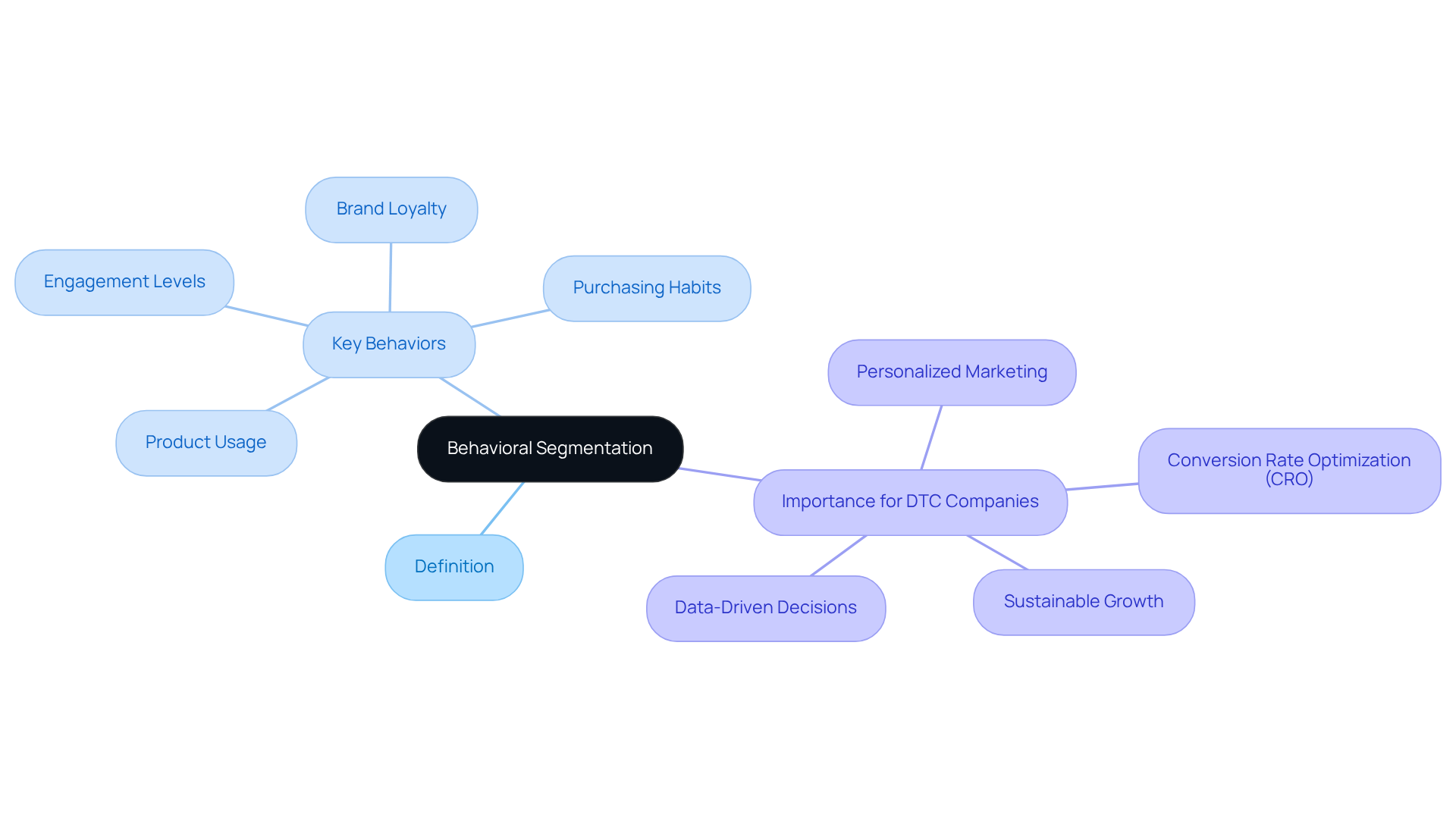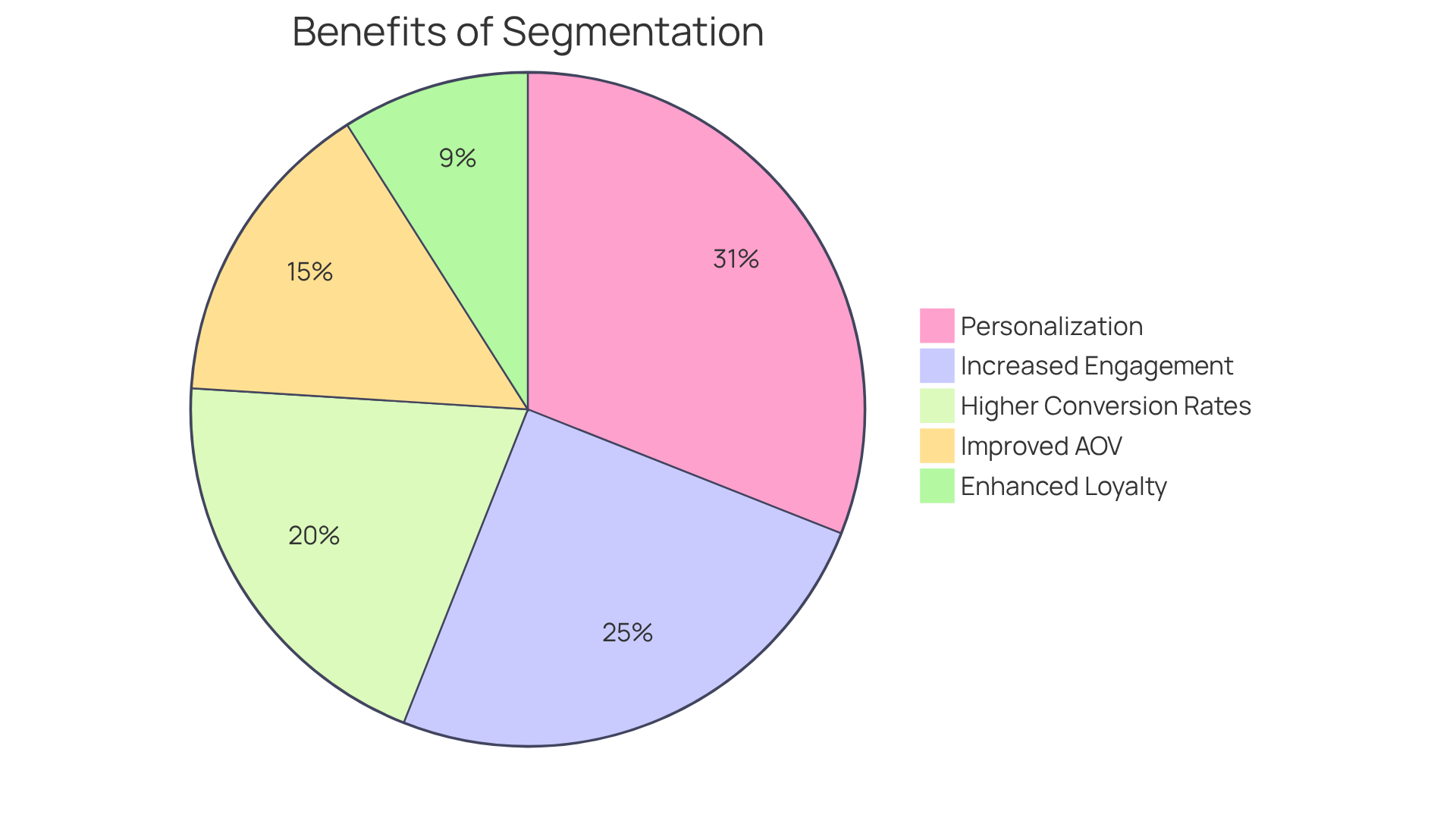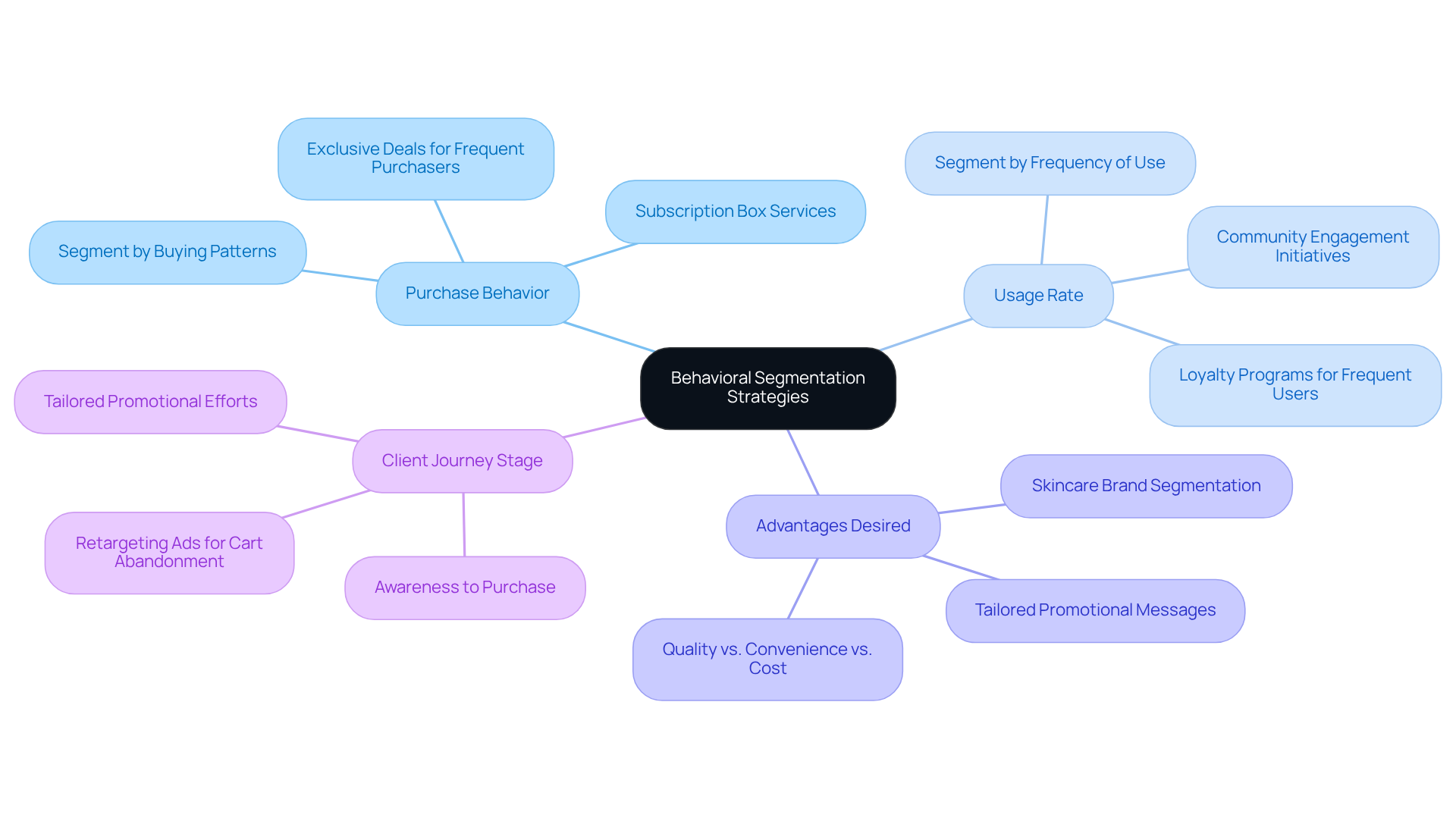
Overview
Behavioral segmentation represents a powerful marketing strategy that categorizes consumers based on their actions, including purchasing habits and brand loyalty. This approach empowers direct-to-consumer (DTC) brands to tailor their marketing efforts with precision. By enhancing consumer experiences and conversion rates, companies can create personalized strategies that resonate with specific audience segments. Ultimately, this drives satisfaction and fosters loyalty among consumers.
Introduction
Understanding consumer behavior is paramount for direct-to-consumer (DTC) brands navigating a rapidly evolving marketplace. Behavioral segmentation presents a strategic framework that empowers these companies to categorize their audiences based on actions and interactions, moving beyond traditional demographic data. This article examines the transformative power of behavioral segmentation, highlighting its significance, benefits, and practical applications for DTC brands. As the landscape transitions towards data-driven marketing, brands must effectively harness these insights to enhance customer engagement and drive conversions.
Define Behavioral Segmentation: Key Concepts and Importance
The behavioral segmentation definition serves as a powerful marketing tactic that categorizes consumers based on their behaviors, actions, and interactions with a company. This approach surpasses traditional demographic segmentation, which focuses on the identity of the buyer, by emphasizing the behavioral segmentation definition that centers on the actions they take. Key behaviors encompass purchasing habits, product usage, brand loyalty, and engagement levels. By understanding the behavioral segmentation definition, companies can comprehend these behaviors and tailor their promotional efforts more effectively, thus enhancing consumer experiences and increasing conversion rates.
For direct-to-consumer (DTC) companies, the behavioral segmentation definition is particularly vital. It empowers them to craft personalized marketing strategies that resonate with their target audience, ultimately leading to greater satisfaction and loyalty. By employing expert Conversion Rate Optimization (CRO) strategies, such as those provided by Parah Group, companies can deepen their understanding of consumer behavior. Parah Group emphasizes profitability and sustainable growth, focusing on data-driven decisions that not only attract visitors but also convert them into loyal customers. This methodology ensures that promotional efforts align with key metrics critical to both the brand and its investors, fostering sustainable growth and profitability.

Explore the Evolution of Behavioral Segmentation in Marketing
The behavioral segmentation definition has undergone a remarkable transformation since its inception. Initially, promotional strategies predominantly focused on demographic information, highlighting aspects such as age, gender, and income. However, the rise of digital promotion and advancements in big data analytics have fundamentally shifted this paradigm. Marketers now recognize the critical importance of understanding consumer behavior, which encompasses tracking online interactions, purchase histories, and engagement metrics. This capability has empowered companies to segment their audiences with greater precision.
Currently, the behavioral segmentation definition is a crucial component of successful promotional strategies, enabling companies to create tailored experiences that align with the distinct needs and preferences of their clients. For instance, companies that effectively segment their email lists experience a 14.31% higher open rate, showcasing the tangible benefits of this approach. Furthermore, a B2B SaaS client achieved a remarkable 35% increase in ROI by concentrating on high-value segments identified through predictive lead scoring, underscoring the effectiveness of behavioral insights.
This evolution indicates a broader trend toward data-driven decision-making in promotional strategies, emphasizing the necessity for brands to adapt to the dynamic nature of consumer behaviors. As Elin Andersson, a journalist specializing in digital promotion, asserts, 'The behavioral segmentation definition is a strategic necessity for next-generation CMOs.' As the landscape continues to evolve, the focus on behavioral insights will only intensify, reinforcing the importance of tailoring marketing efforts to resonate with specific audience segments. Notably, Netflix's sophisticated personalization techniques, which analyze viewer behavior to enhance engagement, exemplify the effective application of behavioral categorization in practice.

Identify Benefits of Behavioral Segmentation for DTC Brands
The behavioral segmentation definition serves as a powerful instrument for DTC companies, enhancing personalization, increasing engagement, and driving conversion rates. By scrutinizing specific consumer behaviors, companies can tailor their marketing communications and offers to resonate with individual preferences, culminating in heightened satisfaction and loyalty. For example, a $30M apparel company that collaborated with Parah Group witnessed a remarkable 35% surge in conversion rates after deploying strategies that emphasized social proof and optimized product pricing. This demonstrates how a deep understanding of client behavior can lead to significant improvements in performance.
Moreover, the behavioral segmentation definition empowers companies to identify high-value clients and optimize their marketing expenditure by focusing on groups that are more inclined to convert. Grab Green, a DTC cleaning product company, realized an impressive 80% increase in average order value (AOV) through targeted promotions and bundling strategies, illustrating the potency of analyzing purchasing behavior. This aligns with the statistic that personalized on-site product recommendations can account for up to 31% of revenue on e-commerce sites, underscoring the necessity of targeted approaches.
Furthermore, the implementation of real-time categorization triggers can actively engage customers based on their immediate actions, amplifying the practical application of behavioral classification. For instance, STRNG Seeds, a cannabis company, achieved a staggering 90% increase in AOV by offering complimentary gifts over a specified cart size and refining their product pages. Overall, the strategic deployment of the behavioral segmentation definition, bolstered by Parah Group's innovative methodologies, can markedly enhance a company's promotional effectiveness and profitability, especially in a competitive landscape.

Examine Types of Behavioral Segmentation: Strategies and Examples
DTC brands can significantly enhance their marketing strategies by leveraging the behavioral segmentation definition to utilize various types of segmentation. This approach not only drives higher conversion rates but also fosters customer loyalty in a competitive marketplace. Key examples include:
-
Purchase Behavior: Segmenting clients based on their buying patterns, such as purchase frequency and average order value, is crucial. For instance, a subscription box service might focus on frequent purchasers with exclusive deals, effectively enhancing client retention and loyalty.
-
Usage Rate: Customers can be divided according to how often they utilize a product or service. Implementing loyalty programs for frequent users incentivizes continued engagement and fosters a sense of community, which is vital for brand growth.
-
Advantages Desired: Understanding what consumers seek to achieve from a product—whether it be quality, convenience, or cost—enables companies to customize their offerings. A skincare brand, for example, could segment its audience into individuals pursuing anti-aging benefits versus those focused on hydration, ensuring that promotional messages align with specific needs.
-
Client Journey Stage: Tailoring promotional efforts according to the individual's status in their buying process—from awareness to consideration to purchase—can significantly improve effectiveness. Strategically utilizing retargeting ads can re-engage individuals who have abandoned their carts, nudging them towards conversion.
By implementing these behavioral segmentation definition strategies, DTC brands can craft highly targeted marketing campaigns that resonate with their audience. This approach enhances engagement and aligns with the evolving expectations of consumers, ultimately driving success in their marketing efforts.

Conclusion
Behavioral segmentation stands as a transformative strategy for direct-to-consumer (DTC) brands, emphasizing consumer actions over mere demographics. This pivotal shift enables brands to craft personalized marketing efforts that resonate profoundly with their audience, ultimately enhancing customer satisfaction and loyalty.
The evolution of behavioral segmentation is significant, marking a transition from traditional demographic approaches to a more nuanced understanding of consumer behavior. Key insights reveal the effectiveness of targeted marketing strategies, evidenced by notable increases in conversion rates and average order values for companies that have embraced this approach. By meticulously analyzing purchase behaviors, usage rates, and customer journey stages, DTC brands can tailor their offerings to meet specific consumer needs.
In today’s competitive landscape, the importance of behavioral segmentation is paramount. It empowers brands to make data-driven decisions that enhance engagement and drive profitability. As consumer expectations continue to evolve, DTC companies must adopt these segmentation techniques to remain relevant and successful. Embracing behavioral insights transcends mere trend; it is a strategic necessity for brands aspiring to thrive in the contemporary market.
Frequently Asked Questions
What is behavioral segmentation?
Behavioral segmentation is a marketing tactic that categorizes consumers based on their behaviors, actions, and interactions with a company, focusing on purchasing habits, product usage, brand loyalty, and engagement levels.
How does behavioral segmentation differ from traditional demographic segmentation?
Unlike traditional demographic segmentation, which focuses on the identity of the buyer, behavioral segmentation emphasizes the actions consumers take, allowing for a deeper understanding of their preferences and behaviors.
Why is behavioral segmentation important for companies?
Behavioral segmentation is important because it enables companies to tailor their promotional efforts more effectively, enhancing consumer experiences and increasing conversion rates.
What specific benefits does behavioral segmentation offer to direct-to-consumer (DTC) companies?
For DTC companies, behavioral segmentation allows them to craft personalized marketing strategies that resonate with their target audience, leading to greater customer satisfaction and loyalty.
How can companies enhance their understanding of consumer behavior?
Companies can enhance their understanding of consumer behavior by employing expert Conversion Rate Optimization (CRO) strategies, which focus on data-driven decisions to attract and convert visitors into loyal customers.
What role does Parah Group play in behavioral segmentation and CRO?
Parah Group provides strategies that emphasize profitability and sustainable growth, helping companies align their promotional efforts with key metrics critical to the brand and its investors.
FAQs











